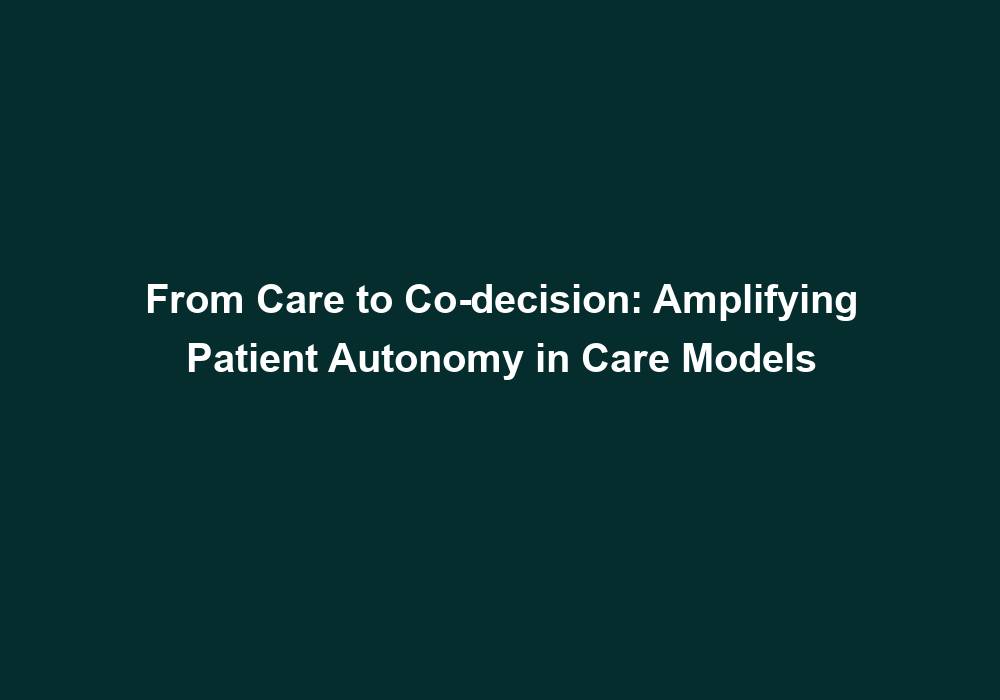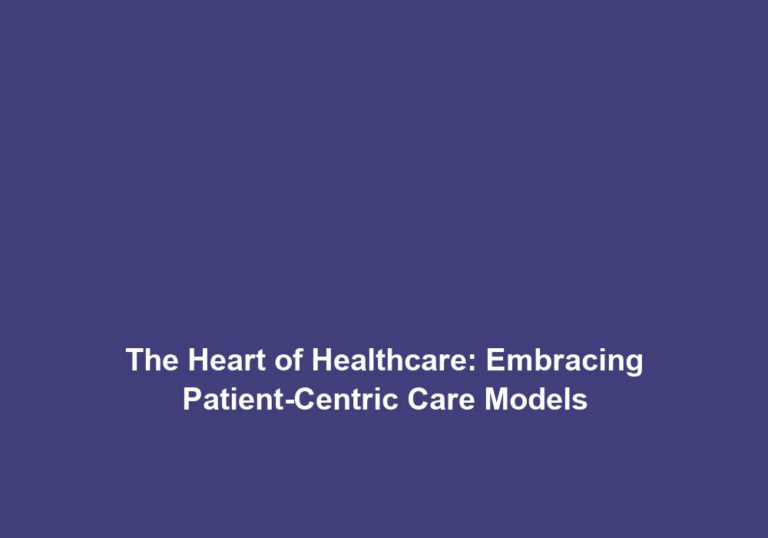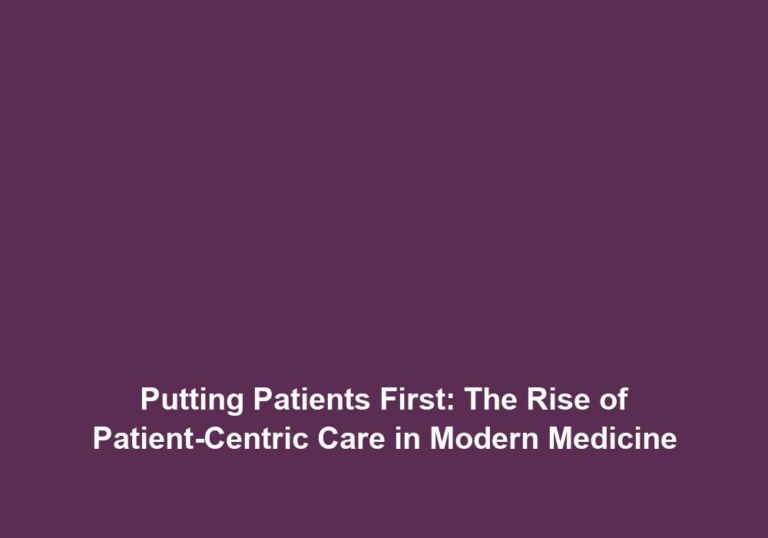From Care to Co-decision: Amplifying Patient Autonomy in Care Models
In recent years, there has been a significant shift in healthcare towards empowering patients and involving them in the decision-making process. This shift recognizes the importance of patient autonomy in determining their own care and treatment options. Traditional care models often placed the healthcare provider at the center of decision-making, leaving patients with limited involvement in their own healthcare journey. However, the tide is turning towards a more patient-centered care approach, where patients are active participants in their care plans.
The Importance of Patient Autonomy
Patient autonomy refers to the right and ability of individuals to make decisions about their own healthcare. It recognizes that patients have unique values, preferences, and goals that should be taken into consideration when determining the course of treatment. Empowering patients with autonomy not only respects their individuality but also leads to better health outcomes.
When patients are actively involved in the decision-making process, they become more engaged and invested in their own care. This can lead to increased adherence to treatment plans, better communication between patients and healthcare providers, and improved overall satisfaction with the healthcare experience. Moreover, patient autonomy fosters a sense of empowerment and control, which can positively impact the mental and emotional well-being of patients.
Patient autonomy can also contribute to better health literacy and patient education. When patients are actively involved in decision-making, healthcare providers have the opportunity to educate them about their conditions, treatment options, and potential risks and benefits. This knowledge empowers patients to make informed decisions and participate in discussions about their care.
Additionally, patient autonomy promotes respect for individual rights and values. Every patient has unique preferences and goals, and by involving them in the decision-making process, healthcare providers acknowledge and honor those individual rights. This not only strengthens the doctor-patient relationship but also contributes to a more patient-centered healthcare system.
Challenges in Amplifying Patient Autonomy
While the concept of patient autonomy sounds promising, there are challenges in practice. One of the main barriers is the historical paternalistic approach to healthcare, where healthcare providers made decisions on behalf of patients. Shifting this long-standing mindset takes time and effort. Healthcare professionals need to recognize the importance of patient autonomy and actively work towards involving patients in the decision-making process.
Additionally, there may be concerns about the competence of patients to make informed decisions, especially in complex medical situations. In such cases, healthcare professionals need to provide adequate information and support to ensure patients can make informed choices. This can be achieved through patient education programs, clear communication, and the use of decision aids that present information in a structured and understandable manner.
Another challenge lies in the existing healthcare systems and structures. Often, care models are designed around the convenience and efficiency of healthcare providers rather than the empowerment of patients. These systems may lack the necessary infrastructure and resources to facilitate shared decision-making and patient autonomy. Overcoming these barriers requires a shift in organizational culture, policy changes, and investments in patient-centered care initiatives.
To address these challenges, healthcare providers and organizations need to prioritize patient autonomy and actively work towards creating a patient-centered care environment.
Strategies for Amplifying Patient Autonomy
To enhance patient autonomy in care models, healthcare providers and organizations can adopt several strategies:
1. Patient Education and Information Sharing
Providing patients with comprehensive and understandable information about their conditions, treatment options, and potential risks and benefits is crucial for informed decision-making. Healthcare providers should take the time to explain medical jargon, answer questions, and ensure patients have access to reliable educational resources. Empowering patients with knowledge enables them to actively participate in discussions and express their preferences.
In addition to verbal communication, healthcare providers can use written materials, videos, and online resources to educate patients about their healthcare options. These resources should be easily accessible and tailored to the individual patient’s needs and preferences.
2. Shared Decision-Making
Shared decision-making involves a collaborative process between healthcare providers and patients, where both parties contribute to the decision-making process. It requires open and honest communication, active listening, and respect for patient preferences. Tools such as decision aids, which present information in a structured manner, can facilitate shared decision-making by providing patients with evidence-based options and helping them evaluate pros and cons.
Shared decision-making also involves considering the patient’s values, preferences, and goals when determining the most appropriate course of treatment. Healthcare providers should engage patients in discussions about their treatment options, explain the potential benefits and risks, and help them make decisions that align with their personal values.
3. Advance Care Planning
Advance care planning involves discussions between patients, their families, and healthcare providers to determine their preferences for future healthcare decisions. This process ensures that patients’ values and goals are considered even when they are unable to make decisions themselves. Healthcare providers should encourage patients to engage in advance care planning, allowing them to have a voice in their care, even in challenging circumstances.
Advance care planning discussions should cover topics such as end-of-life care, resuscitation preferences, and the appointment of a healthcare proxy. These discussions should be ongoing and regularly revisited to reflect any changes in the patient’s preferences or health status.
4. Incorporating Patient Feedback
To truly amplify patient autonomy, healthcare providers need to actively seek and incorporate patient feedback. This can be done through surveys, focus groups, and patient advisory councils. Patient feedback provides valuable insights into the patient experience, identifies areas for improvement, and helps shape care models that prioritize patient autonomy.
Healthcare organizations should establish mechanisms for collecting and analyzing patient feedback, such as online platforms, suggestion boxes, or dedicated patient feedback teams. The feedback collected should be used to drive continuous improvement and inform decision-making processes within the organization.
5. Cultural Sensitivity and Diversity
Recognizing the diversity of patients’ backgrounds, cultures, and beliefs is essential in promoting patient autonomy. Healthcare providers should develop cultural competency and sensitivity to ensure that care plans are respectful of individual values and preferences. By embracing cultural diversity, healthcare systems can better serve their diverse patient populations and foster patient autonomy.
Cultural sensitivity involves understanding and respecting the beliefs, values, and traditions of different cultural groups. Healthcare providers should strive to provide culturally competent care by tailoring their approaches to the specific needs of each patient. This includes ensuring language access, considering cultural practices and preferences, and involving interpreters or cultural mediators when necessary.
Conclusion
Amplifying patient autonomy in care models is essential for promoting patient-centered care and improving health outcomes. By recognizing the importance of patient autonomy, addressing existing challenges, and implementing strategies for shared decision-making, healthcare providers and organizations can empower patients to take an active role in their own healthcare journey. Embracing patient autonomy not only enhances the quality of care but also promotes patient satisfaction and overall well-being.






